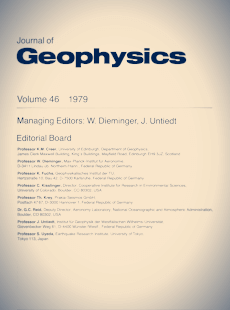Finite element convection models: comparison of shallow and deep mantle convection, and temperatures in the mantle
Article Sidebar

Vols. 1-18 (1924-1944), ISSN 0044-2801
Main Article Content
Abstract
A Finite Element Method for solving the convection problem in a fluid with position-dependent Newtonian viscosity is developed, using bicubic and biquadratic spline functions on a rectangular grid. Introducing weak (less viscous) zones at the active margins of the lithosphere, dynamical mantle convection models are established which have a nearly uniform surface (plate) velocity and a satisfactory heat flux profile. A comparison of upper and deep mantle convection shows:
— a moderate increase of viscosity with depth cannot confine the flow to the upper mantle;
— in shallow depth convection models the temperature is too low inside the cell, but deep mantle convection models yield satisfactory temperatures for the upper mantle.
For that reason deep (or whole) mantle convection should be the favored hypothesis.
 ARK: https://n2t.net/ark:/88439/y025744
ARK: https://n2t.net/ark:/88439/y025744
Permalink: https://geophysicsjournal.com/article/202
Article Details
References
Bickle, M.J. (1978) Heat loss from the earth: a constraint on Archean tectonics from the relation between geothermal gradients and the rate of plate production. Earth Planet. Sci. Lett. 40:301-315
Davies, G.F. (1977) Whole-mantle convection and plate tectonics. Geophys. J. R. Astron. Soc. 49:459-486
DeBremaecker, J.-Cl. (1977a) Convection in the earth's mantle. Tectonophysics 41:195-208
DeBremaecker, J.-Cl. (1977b) Is the oceanic lithosphere elastic or viscous? J. Geo phys. Res. 82:2001-2004
Dickinson, W.R., Luth, W.C. (1971) A model for plate tectonic evolution of mantle layers. Science 174:400-404
Elsasser, W.M., Olson, P., Marsh, B.D. (1979) The Depth of Mantle Convection. J. Geophys. Res. 84:147-155
Fusijawa, H. (1968) Temperature and discontinuities in the transition layer within the earth's mantle: geophysical application of the olivine-spinel transition in the Mg2SiO4-Fe2SiO4 system. J. Geophys. Res. 73:3281-3294
Garfunkel, Z. (1975) Growth, shrinking, and long-term evolution of plates and their implications for the flow pattern in the mantle. J. Geophys. Res. 80:4425-4432
Gebrande, H. (1975) Ein Beitrag zur Theorie thermischer Konvektion im Erdman tel mit besonderer Berucksichtigung der Moglichkeit eines Nachweises mit Methoden der Seismologie. University of Munich, Diss. Inst. for General and Applied Geophysics
Graham, E.K. (1970) Elasticity and composition of the upper mantle. Geophys. J. R. Astron. Soc. 20:285-302
Graham, E.K., Dobrzykowski, D. (1976) Temperatures in the mantle as inferred from simple compositional models. Am. Mineral. 61:549-559
Higgins, G., Kennedy, G.C. (1971) The adiabatic gradient and the melting point gradient in the core of the earth. J. Geophys. Res. 76:1870-1878
Houston, M.H., DeBremaecker, J.-Cl. (1975) Numerical models of convection in the upper mantle. J. Geophys. Res. 80:742-751
Jones, G.M. (1977) Thermal interaction of the core and the mantle and long-term behaviour of the geomagnetic field. J. Geo phys. Res. 82:1703-1709
Jordan, T.H. (1977) Lithospheric slab penetration into the lower mantle beneath the Sea of Okhotsk. J. Geophys. 43:473-496
Kanamori, H., Fujii, N., Mizutani, H. (1968) Thermal diffusivity measurements of rock-forming minerals from 300° to 1100° K. J. Geophys. Res. 73:595-605
Leppaluoto, D.A. (1972) Melting of iron by significant structure theory. Phys. Earth Planet. Inter. 6:175-181
McGregor, I.D., Basu, A.R. (1974) Thermal structure of the lithosphere: a petrological model. Science 185:1007-1011
McKenzie, D.P., Roberts, J.M. (1974) Convection in the earth's mantle: towards a numerical simulation. J. Fluid Mech. 62:465-538
Mercier, J.-Cl., Carter, N.L. (1975) Pyroxene geotherms. J. Geophys. Res. 80:3349-3362
O'Connell, R.J. (1977) On the scale of mantle convection. Tectonophysics 38:119-136
Parsons, B., McKenzie, D. (1978) Mantle convection and the thermal structure of plates. J. Geophys. Res. 83:4419-4430
Prenter, P.M. (1975) Splines and variational methods. John Wiley and Sons, New York
Richter, F.M. (1973) Convection and large scale circulation of the mantle. J. Geophys. Res. 78:8735-8745
Richter, F.M., McKenzie, D. (1978) Simple plate models of mantle convection. J. Geophys. 44:441-471
Richter, F.M., Parsons, B. (1975) On the interaction of two scales of convection in the mantle. J. Geophys. Res. 80:2529-2541
Ringwood, A.E. (1975) Composition and petrology of the earth's mantle. McGraw-Hill, New York
Sammis, C.G., Smith, J.C., Schubert, G., Yuen, D.A. (1977) Viscosity-depth profile of the earth's mantle: effects of polymorphic phase transitions. J. Geophys. Res. 82:3747-3761
Sato, A., Thompson, E.G. (1976) Finite element models for creeping convection. J. Comput. Phys. 22:229-244
Schatz, J.F., Simmons, G. (1972) Thermal conductivity of earth materials at high temperatures. J. Geophys. Res. 77:6966-6983
Schubert, G., Froidevaux, C., Yuen, D.A. (1976) Oceanic lithosphere and asthenosphere: thermal and mechanical structure. J. Geophys. Res. 81:3525-3540
Sclater, J.G., Crowe, J. (1976) On the reliability of oceanic heat flow averages. J. Geophys. Res. 81:2997-3006
Stacey, F.D. (1977) A thermal model of the earth. Phys. Earth Planet. Inter. 15:341-348
Tolland, H.G. (1974) Thermal regime of the earth's core and lower mantle. Phys. Earth Planet. Inter. 8:282-286
Torrance, K.E., Turcotte, D.L., Hsui, A.T. (1973) Convection in the earth's mantle. In: Bolt, B.A. (Ed.) Methods in computational physics, Vol. 13, pp. 431-454. Academic Press, New York, London
Tozer, D.C. (1970) Temperature, conductivity, composition and heat flow. J. Geomagn. Geoelectr. 22:35-51
Walcott, R.I. (1970) Flexural rigidity, thickness, and viscosity of the lithosphere. J. Geophys. Res. 75:3941-3954
Wang, C.Y. (1972) Temperature in the lower mantle. Geophys. J. R. Astron. Soc. 27:29-36
Watt, J.P., O'Connell, R.J. (1978) Mixed-oxide and perovskite-structure model mantles from 700-1200 km. Geophys. J. R. Astron. Soc. 54:601-630
Zienkiewicz, O.C. (1977) The finite element method, 3rd edn. McGraw-Hill, London











